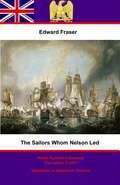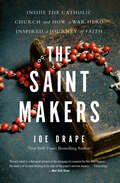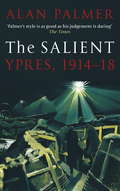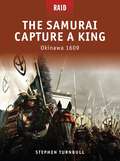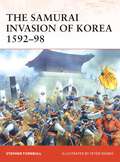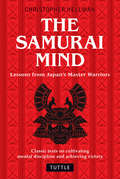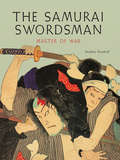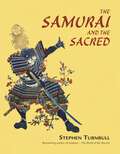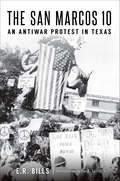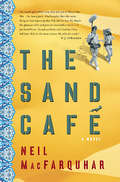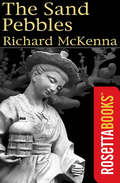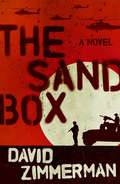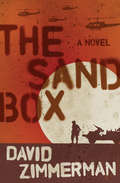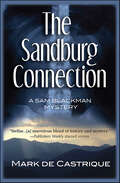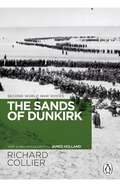- Table View
- List View
The Sailors Whom Nelson Led: Their Doings Described By Themselves (classic Reprint)
by Edward FraserThis ebook is purpose built and is proof-read and re-type set from the original to provide an outstanding experience of reflowing text for an ebook reader. Of the many famous, courageous leaders of the Napoleonic Wars, and on sea beyond that era, few stand as high in estimation as Horatio Nelson, lauded by his countrymen, respected by his enemies, and despite his lack of understanding of warfare on the waves by the Emperor Napoleon himself. His tale of glory was short but blazingly bright, terminating at Trafalgar in 1805, having made his name at the battle of the Nile and Copenhagen earlier in the wars. However, the wars with France thereafter did not terminate until 1815, with a brief respite in 1814; how then, without Nelson, was the supremacy of the Royal Navy maintained? Edward Fraser provides a good deal of the answer in his book, which seeks to sketch a picture of the captains, officers, and sailors who executed Nelson's orders with gusto, determination and, in many cases, with some of their own flair. The "Band of Brothers" that Nelson led and inspired are described in detail - their actions and deeds, which may have been outshone by those of their leader - but they were great fighting men in their own right, Codrington, Suamarez, Troubridge et al. Fraser is adept at using the sources of all ranks and includes the ordinary seaman's view as well as more junior officers, to complete the view of the sailors who fought and won the war on the seas. Highly recommended. Text taken, whole and complete, from the 1913 edition, published by Methuen and Co Ltd., London. Original -353 pages Illustrations - 16 - all included Maps - 4 - all included Author - Edward Fraser - (????-????) Linked TOC.
The Saint Makers: Inside the Catholic Church and How a War Hero Inspired a Journey of Faith
by Joe DrapePart biography of a wartime adventurer, part detective story, and part faith journey, this intriguing book from New York Times journalist and bestselling author Joe Drape takes us inside the modern-day process of the making of a saint.The Saint Makers chronicles the unlikely alliance between Father Hotze and Dr. Andrea Ambrosi, a country priest and a cosmopolitan Italian canon lawyer, as the two piece together the life of a long dead Korean War hero and military chaplain and fashion it into a case for eternal divinity. Joe Drape offers a front row seat to the Catholic Church's saint-making machinery-which, in many ways, has changed little in two thousand years-and examines how, or if, faith and science can co-exist.This rich and unique narrative leads from the plains of Kansas to the opulent halls of the Vatican, through brutal Korean War prison camps, and into the stories of two individuals, Avery Gerleman and Chase Kear, whose lives were threatened by illness and injury and whose family and friends prayed to Father Kapaun, sparking miraculous recoveries in the heart of America. Gerleman is now a nurse, and Kear works as a mechanic in the aerospace industry. Both remain devoted to Father Kapaun, whose opportunity for sainthood relies in their belief and medical charts. At a time when the church has faced severe scandal and damage, and the world is at the mercy of a pandemic, this is an uplifting story about a priest who continues to an example of goodness and faith.Ultimately, The Saint Makers is the story of a journey of faith -- for two priests separated by seventy years, for the two young athletes who were miraculously brought back to life with (or without) the intercession of the divine, as well as for readers -- and the author -- trying to understand and accept what makes a person truly worthy of the Congregation of Saints in the eyes of the Catholic Church.
The Salamander and the Fire
by Dan DavinDan Davin, the respected New Zealand writer, and former Publisher of Oxford University Press, served as an Intelligence Officer during the Second World War. This volume brings together all of his published stories about the war, as well as several that have never been in print before. Included is his best-known story, "The General and the Nightingale," a moving salute to the general under whom he served.
The Salient: Ypres, 1914-18
by Alan PalmerYpres today is an international 'Town of Peace', but in 1914 the town, and the Salient, the 35-mile bulge in the Western Front, of which it is part, saw a 1500-day military campaign of mud and blood at the heart of the First World War that turned it into the devil's nursery. Distinguished biographer and historian of modern Europe Alan Palmer tells the story of the war in Flanders as a conflict that has left a deep social and political mark on the history of Europe. Denying Germany possession of the historic town of Ypres and access to the Channel coast was crucial to Britain's victory in 1918. But though Flanders battlefields are the closest on the continent to English shores, this was always much more than a narrowly British conflict. Passchendaele, the Menin Road, Hill 60 and the Messines Ridge remain names etched in folk memory. Militarily and tactically the four-year long campaign was innovative and a grim testing ground with constantly changing ideas of strategy and disputes between politicians and generals. Alan Palmer details all its aspects in an illuminating history of the place as much as the fighting man's experience.
The Salient: Ypres, 1914-18
by Alan PalmerYpres today is an international 'Town of Peace', but in 1914 the town, and the Salient, the 35-mile bulge in the Western Front, of which it is part, saw a 1500-day military campaign of mud and blood at the heart of the First World War that turned it into the devil's nursery. Distinguished biographer and historian of modern Europe Alan Palmer tells the story of the war in Flanders as a conflict that has left a deep social and political mark on the history of Europe. Denying Germany possession of the historic town of Ypres and access to the Channel coast was crucial to Britain's victory in 1918. But though Flanders battlefields are the closest on the continent to English shores, this was always much more than a narrowly British conflict. Passchendaele, the Menin Road, Hill 60 and the Messines Ridge remain names etched in folk memory. Militarily and tactically the four-year long campaign was innovative and a grim testing ground with constantly changing ideas of strategy and disputes between politicians and generals. Alan Palmer details all its aspects in an illuminating history of the place as much as the fighting man's experience.
The Salt of the Earth: A History of Norwegian-Danish Methodism in America
by Arlow W. AndersenDive into the rich and inspiring history of Norwegian-Danish Methodism in America with Arlow W. Andersen's The Salt of the Earth: A History of Norwegian-Danish Methodism in America. This meticulously researched book chronicles the remarkable journey of Norwegian and Danish immigrants who brought their Methodist faith to the New World, shaping the religious and cultural landscape of American society.Andersen traces the origins and development of this unique religious movement, from its early beginnings in the mid-19th century to its growth and establishment across the United States. Through detailed narratives and personal stories, the book highlights the resilience, dedication, and faith of the Norwegian-Danish Methodist community as they navigated the challenges of immigration, assimilation, and cultural preservation.Readers will explore the key figures, pivotal moments, and significant contributions of Norwegian-Danish Methodists, including their efforts in founding churches, educational institutions, and social organizations. Andersen's engaging storytelling brings to life the vibrant communities that flourished despite adversity, driven by a shared sense of purpose and faith.The Salt of the Earth is not just a history of a religious group; it is a testament to the enduring spirit of immigrants who sought to create a better life while staying true to their beliefs. This book is an essential read for anyone interested in religious history, immigration studies, and the cultural heritage of Scandinavian-Americans. Andersen's work offers a profound understanding of how faith and perseverance can shape a community and leave a lasting legacy.
The Salvador Option
by Russell CrandallEl Salvador's civil war between the Salvadoran government and Marxist guerrillas erupted into full force in early 1981 and endured for eleven bloody years. Unwilling to tolerate an advance of Soviet and Cuban-backed communism in its geopolitical backyard, the US provided over six billion dollars in military and economic aid to the Salvadoran government. El Salvador was a deeply controversial issue in American society and divided Congress and the public into left and right. Relying on thousands of archival documents as well as interviews with participants on both sides of the war, The Salvador Option offers a thorough and fair-minded interpretation of the available evidence. If success is defined narrowly, there is little question that the Salvador Option achieved its Cold War strategic objectives of checking communism. Much more difficult, however, is to determine what human price this 'success' entailed - a toll suffered almost entirely by Salvadorans in this brutal civil war.
The Samurai Banner of Furin Kazan
by Yasushi Inoue Yoko RileyOriginally published in Japanese in 1959, this classic novel by Yasushi Inoue takes place during the Japanese Warring Era (1467-1573)-a time when Japan was ruled by three young powerful warlords: Takeda Shingen, Iwagawa Yoshimoto, and Hojo Ujiyasu. The story focuses on Takeda Shingen and his one-eyed, crippled strategist, Yamamoto Kansuke. The brilliant strategies of Kansuke, inspired by his passion for war and his admiration for his enemies' war tactics, are beautifully expressed throughout this book.
The Samurai Banner of Furin Kazan
by Yasushi Inoue Yoko RileyOriginally published in Japanese in 1959, this classic novel by Yasushi Inoue takes place during the Japanese Warring Era (1467-1573)-a time when Japan was ruled by three young powerful warlords: Takeda Shingen, Iwagawa Yoshimoto, and Hojo Ujiyasu. The story focuses on Takeda Shingen and his one-eyed, crippled strategist, Yamamoto Kansuke. The brilliant strategies of Kansuke, inspired by his passion for war and his admiration for his enemies' war tactics, are beautifully expressed throughout this book.
The Samurai Capture a King: Okinawa 1609
by Stephen Turnbull Richard HookA brilliant but little-known operation, the Shimazu clan raid on the independent kingdom of Ryukyu (modern Okinawa) in 1609 is one of the most extraordinary episodes in samurai history and the culmination of centuries of rivalry between the two powers. The defeat of the Shimazu at Sekigahara in 1600, and their need to win favour with the new Shogun, led them to hatch an audacious plot to attack the islands on the Shogun's behalf and bring back the king of Ryukyu as a hostage. Stephen Turnbull gives a blow-by-blow account of the operation, from the daring Shimazu amphibious landing, to their rapid advance overland, and the tactical feigned retreat that saw the Shimazu defeat the Okinawan army and kidnap their king in spectacular fashion. With a detailed background and specially commissioned artwork, the scene is set for a dramatic retelling of this fascinating raid.
The Samurai Invasion of Korea 1592-98
by Peter Dennis Stephen TurnbullThe invasions of Korea launched by the dictator Toyotomi Hideyoshi (1592-1593 and 1597-1598) are unique in Japanese history for being the only time that the samurai assaulted a foreign country. Hideyoshi planned to invade and conquer China, ruled at the time by the Ming dynasty, and when the Korean court refused to allow his troops to cross their country, Korea became the first step in this ambitious plan of conquest. In 1592 a huge invasion force of 150,000 men landed at the ports of Busan and Tadaejin under the commanders Konishi Yukinaga and Kato Kiyomasa. These two Japanese divisions rapidly overran their Korean counterparts, taking the principal cities of Seoul and then Pyongyang and driving the remnants of the Korean Army into China. The Japanese division under Kato Kiyomasa even started to advance into Manchuria. However, the Korean strength was in their navy and the vital Korean naval victory of Hansando disrupted the flow of supplies to the invasion forces, forcing them to hold their positions around Pyongyang. In 1593, the Chinese invaded capturing Pyongyang from the Japanese and driving them southwards. This phase of the war ended in a truce, with the Japanese forces withdrawing into enclaves around the southern port of Busan while the Ming armies largely withdrew to China. In 1597, following the breakdown in negotiations, the Japanese invaded again with a force of 140,000 men. However, the Chinese and Koreans were now better prepared and the advance came to a halt south of Seoul, and then forced the Japanese southwards. In November 1598 Hideyoshi died, and with him the enthusiasm for the military adventure. The Japanese council of regents ordered the withdrawal of the remaining forces, and the naval battle of Noryang, which saw the Japanese fleet annihilated by the Korean admiral Yi-Sunshin, proved to be the last significant act of the conflict.
The Samurai Mind
by Christopher HellmanThe Samurai Mind is a collection of five seminal Japanese texts which together convey the very essence of the traditional samurai warrior ethos. These texts range from the ferocious to the esoteric--with their common thread being the importance of mastering one's own mind as the key to overcoming opponents. Written from the mid-18th to early 19th century, the authors were acknowledged master warriors keen to address a broader audience beyond their circle of students and acolytes. Their aim was to explain their craft to the outside world, and they do so with great insight.
The Samurai Mind
by Christopher HellmanThe Samurai Mind is a collection of five seminal Japanese texts which together convey the very essence of the traditional samurai warrior ethos. These texts range from the ferocious to the esoteric--with their common thread being the importance of mastering one's own mind as the key to overcoming opponents. Written from the mid-18th to early 19th century, the authors were acknowledged master warriors keen to address a broader audience beyond their circle of students and acolytes. Their aim was to explain their craft to the outside world, and they do so with great insight.
The Samurai Swordsman
by Stephen TurnbullThe word "samurai" evokes intense images of indomitable warriors, expert swordsmen capable of taking on overwhelming odds-and emerging victorious. But this popular image only brushes the surface of the samurai tradition. The Samurai Swordsman: Master of War brings to life the history behind the courageous and highly disciplined fighting men of early Japan.Authoritative military history expert Stephen Turnbull shows how the samurai evolved from the primitive fighters of the 7th century into an invincible military caste with a fearsome reputation. Many aspects of the samurai and their military significance are covered, including the cultural reasons why the elite mounted archers originally emerged in Japan; their wars against pirate invaders; how samurai masters taught the next generation; the women samurai and their accomplishments; and much more. Illustrated with full-color historical images that show the samurai tradition in fascinating detail, The Samurai Swordsman is an invaluable guide to an enduring legacy.
The Samurai Swordsman
by Stephen TurnbullThe word "samurai" evokes intense images of indomitable warriors, expert swordsmen capable of taking on overwhelming odds-and emerging victorious. But this popular image only brushes the surface of the samurai tradition. The Samurai Swordsman: Master of War brings to life the history behind the courageous and highly disciplined fighting men of early Japan.Authoritative military history expert Stephen Turnbull shows how the samurai evolved from the primitive fighters of the 7th century into an invincible military caste with a fearsome reputation. Many aspects of the samurai and their military significance are covered, including the cultural reasons why the elite mounted archers originally emerged in Japan; their wars against pirate invaders; how samurai masters taught the next generation; the women samurai and their accomplishments; and much more. Illustrated with full-color historical images that show the samurai tradition in fascinating detail, The Samurai Swordsman is an invaluable guide to an enduring legacy.
The Samurai and the Sacred: The Path of the Warrior
by Stephen TurnbullThe samurai were celebrated warriors, but they were also deeply spiritual men whose religious beliefs sustained and inspired their forays into battle. In this entirely original work, Stephen Turnbull, a leading authority on Japanese history and author of more than 50 books, reveals the soul of the samurai in a thoughtful exploration of the religions and philosophies that motivated them. Drawing inspiration from all manners of belief systems - from Japan's mainstream religions of Shinto and Buddhism, to Confucianism, Christianity, and Folk Religion - the samurai were fascinating men who often valued their honor above their lives.THE SAMURAI AND THE SACRED is strikingly illustrated with lavish Japanese prints and vibrant photographs. A provocative study, it includes chapters on martial arts, modern militarism, the cult of the sword, revenge, suicide, hara kiri and kamikaze pilots. THE SAMURAI AND THE SACRED is a compelling read that provides insight into Japanese culture, philosophy, and warfare.From the Hardcover edition.
The San Marcos 10: An Antiwar Protest in Texas
by E.R. BillsOn November 13, 1969, ten students at Texas State University were suspended for participating in a peaceful protest against the Vietnam War. They had kept vigil in front of the Huntington Mustangs, bearing signs that read,"Vietnam Is an Edsel" and "44,000 U.S. Dead, For What?" while an increasingly hostile anti-protest crowd chanted, "Love it or leave it!" and "Let's string 'em up!" It was a day after news of the My Lai massacre broke. Part of a coordinated, nationwide Vietnam Moratorium effort that confounded and infuriated the Nixon White House, the "San Marcos 10" challenged their suspension, taking their case all the way to the United States Supreme Court. Author E.R. Bills offers this fascinating glimpse into the 1960s antiwar movement in Texas, the extraordinary measures to quell it and the broader social activism in which it participated.
The Sand Cafe: A Novel
by Neil MacfarquharA fierce, funny debut novel of journalists at war? or waiting for one that never quite arrives? based on the Gulf War experiences of a renowned "New York Times" correspondent
The Sand Creek Massacre: A Documentary History
by Sol LewisFirst published as a report of the Joint Committee on the Conduct of the War, Massacre of the Cheyenne Indians, 38th Congress, Second Session, Washington, 1865; and report of the Secretary of War, 39th Congress, Second Session, Senate Executive Document No. 26, Washington, 1867 The edition includes the reply of Governor Evans of the Territory of Colorado, 1865 Reprinted 1973 in a one-volume Limited Edition of 500 copies by Sol Lewis Special Contents 1973 ® by Sol Lewis
The Sand Pebbles (Bluejacket Bks.)
by Richard McKennaThe critically acclaimed New York Times bestseller and the basis for the Academy Award– and Golden Globe–nominated film starring Steve McQueen. As a spirit of nationalism inspired by Chiang Kai-shek&’s leadership begins to sweep through China, the river gunship San Pablo is ordered to patrol the region and to protect US citizens. Jack Holman is a machinist aboard the San Pablo, who has joined the navy in order to avoid jail time. Because he is so fiercely independent, Jake remains a relative loner and is uncomfortable with navy protocol and discipline. Holman&’s independent mind chafes against military hierarchy and also ensures that he does not share his shipmates&’ disdain for the Chinese. Instead, Holman is fascinated with the culture and the people that surround him and develops emotional bonds that prove quite thorny when the circumstances become more tumultuous and more dire. The perspective of The Sand Pebbles is therefore both panoramic as well as personal. Like Lawrence of Arabia, the tension explored here is between the self as individual against the broader spectrum of social and historical forces against which we are all measured. &“A bold well-written book, inclusive in its concepts, memorable in character and incident, fearlessly impartial in its delineation of the incompatible sets of values held by the men on all sides.&” —Kirkus Reviews
The Sandbox
by David ZimmermanOperating Base Cornucopia. A three-hundred-year-old fortress in the remote Iraqi desert where a few dozen soldiers wait for their next assignment, among them Private Toby Durrant, a self-described "broke nobody." Then a deadly ambush touches off events that put Durrant in the middle of a far-reaching conspiracy. Insurgents massing in the nearby hills, a secretive member of military intelligence, an abandoned toy factory and a mysterious, half-feral child--Durrant must figure out the links between them if he's to survive. This blistering look at military life in "the sandbox" of Iraq marks the debut of a major new talent.
The Sandbox: A Novel
by David ZimmermanThis “gripping” and suspenseful novel of the Iraq War “will keep you turning the pages” (The New York Times). Operating Base Cornucopia is a three-hundred-year-old fortress in the remote Iraqi desert where a few dozen soldiers wait for their next assignment, among them Pvt. Toby Durrant, a self-described “broke nobody.” Then a deadly ambush touches off events that put Durrant in the middle of a far-reaching conspiracy. Insurgents massing in the nearby hills, a secretive member of military intelligence, an abandoned toy factory, and a mysterious, half-feral child—Durrant must figure out the links between them if he’s to survive. This blistering look at military life in “the sandbox” of Iraq is both a compelling mystery and a vivid evocation of an “isolated moonscape—a place as liable to produce hallucinations and heat exhaustion as it is to churn up sandstorms that last for days” (Los Angeles Times).
The Sandburg Connection: A Sam Blackman Mystery (Blackman Agency Investigations #3)
by Mark de Castrique"[A] marvelous blend of history and mystery..." —Publishers Weekly STARRED reviewIt should have been routine, a simple assignment for PI Sam Blackman and his partner Nakayla Robertson. Follow a history professor who's suing a spinal surgeon for malpractice and catch her in physical activities that undercut her claim.When professor Janice Wainwright visits Connemara, Carl Sandburg's home in Flat Rock, N.C., and climbs the arduous trail to the top of Glassy Mountain, Sam believes he has the evidence needed to expose her—until he finds the woman semiconscious and bleeding on the mountain's granite outcropping. Her final words: "It's the Sandburg verses. The Sandburg verses."As the person to discover the dying woman, Sam becomes the first suspect. An autopsy reveals painkillers in her blood and solid proof of the surgeon's errors. Why did this suffering woman attempt to climb the mountain? Did she stumble and fall? Did someone cause her death?A break-in at the Wainwright farmhouse and the theft of Sandburg volumes convince Sam someone is seeking potentially deadly information. But what did Pulitzer Prize winner Sandburg have in his literary collection that inspires multiple murders? And who will be targeted next?
The Sands of Dunkirk (Second World War Voices)
by Richard CollierPart of the SECOND WORLD WAR VOICES series, with a new introduction by bestselling historian James Holland, and in partnership with the podcast We Have Ways of Making You Talk, presented by comedian Al Murray and James HollandMay 1940: In the face of a lightning German advance, the British Army found themselves, stunned, broken, beaten, their backs truly against the wall on the sands of the north French coast.And yet it was on the beaches of Dunkirk that the seeds of a remarkable victory were sown. The evacuation of over three hundred thousand men in ships of all sizes was a logistical feat which has never been seen, before or since.This vivid, visceral story takes you inside the making of a miracle: the story of eight frantic days, as the net tightened around the beleaguered troops, told from all sides, as the enemy draws closer and the bombardment intensifies, in the words of those who were there. It is impossible to get closer to experiencing this legendary action.
The Saratoga Campaign: Maneuver Warfare, the Continental Army, and the Birth of the American Way of War
by Maj. Paul D. MontanusThe Saratoga Campaign (June-October 1777) was a watershed event for the United States. The American conduct of the campaign is a textbook study in the application of the tenets of maneuver warfare principles at the operational and tactical levels. General Schuyler's brilliant shaping campaign against the British Forces as they advanced from Fort Ticonderoga to Albany forced General Burgoyne to detach elements of his force, which the Americans were able to isolate, mass forces against, and destroy. Ultimately, Schuyler's shaping cased the British campaign to culminate prior to the main engagements, known as the first and second battles of Saratoga. Occupying a prepared Defensive Position North of Saratoga, the Americans, led by General Arnold, conducted a forward oriented Defense that seized the initiative from the British and disrupted their preconceived plans. The American counter-attacks which demonstrated the American Mastery of seeking gaps and avoiding surfaces, attrited the British Force to such an extent that they were forced to surrender. The victory of the makeshift American Force over the Professional British-Led Force demonstrates the superiority of maneuver warfare versus Attritionist Techniques, and is of contemporary interest to the USMC.Richly illustrated throughout.
